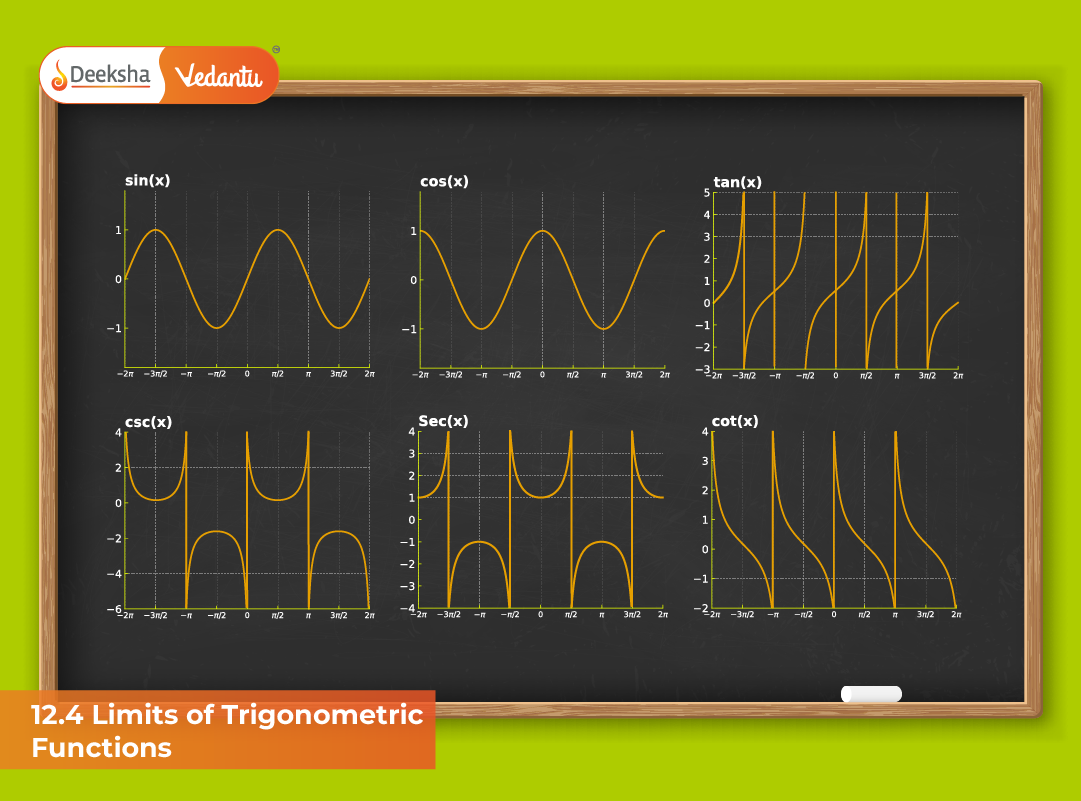
Trigonometric functions play an essential role in calculus, particularly in understanding how a function behaves as its variable approaches certain values like 0, π/2, or π. This topic acts as the connecting link between algebraic limits and differentiation. For JEE aspirants, learning limits of trigonometric functions is vital because it builds conceptual strength for derivatives, continuity, and integral calculus. The chapter also helps in simplifying complex expressions involving sine, cosine, and tangent functions, which frequently appear in JEE Main and Advanced.
Marks Weightage in JEE
The topic “Limits of Trigonometric Functions” generally contributes around 3–4 marks in JEE Main and up to 6 marks in JEE Advanced when integrated with questions involving continuity, differentiability, or series expansion. The weightage may vary, but its conceptual applications make it a must-prepare chapter. Students who master this topic often find questions on derivatives and limits easier to solve within seconds.
JEE questions from this topic may include:
- Direct standard limit evaluations.
- Questions mixing algebraic and trigonometric forms.
- Complex problems needing L’Hôpital’s Rule or trigonometric substitutions.
What Are the Limits of Trigonometric Functions?
A limit helps determine the value that a function approaches when its input tends toward a particular number. When dealing with trigonometric functions, this involves examining the behavior of sin x, cos x, and tan x as x approaches critical points such as 0, π/2, or π. Many trigonometric limit problems result in indeterminate forms such as 0/0 or ∞/∞, which require algebraic or trigonometric manipulation to resolve.
For example:
- lim(x→0) (sin x / x) = 1
- lim(x→0) ((1 – cos x) / x²) = 1/2
- lim(x→0) (tan x / x) = 1
These results are known as standard trigonometric limits and form the basis for solving more complex problems that appear in calculus and physics.
Understanding the Behavior of Trigonometric Functions Near Zero
As x approaches zero, trigonometric functions behave predictably, which allows us to approximate and simplify expressions. These behaviors are crucial to understand because they underlie all limit-based simplifications.
- sin x ≈ x (for small x)
- tan x ≈ x (for small x)
- cos x ≈ 1 − x²/2 (for small x)
Hence, when x is very close to zero, we can replace sin x or tan x with x without affecting accuracy for limit evaluation.
For example:
lim(x→0) (sin 3x / 5x) = 3/5.
This shows that the trigonometric function scales proportionally with its argument.
Understanding this proportionality makes it easier to deal with advanced calculus problems where trigonometric and algebraic limits are combined.
Common Standard Limits
Memorizing standard limits is critical for efficiency in exams. The most important ones include:
- lim(x→0) (sin x / x) = 1
- lim(x→0) (tan x / x) = 1
- lim(x→0) ((1 – cos x) / x²) = 1/2
- lim(x→0) ((sin ax) / (bx)) = a/b
- lim(x→0) ((tan ax) / (bx)) = a/b
Each of these is commonly used in substitution problems. The first one, in particular, forms the foundation for defining derivatives of trigonometric functions.
Using Trigonometric Identities to Simplify Limits
When direct substitution leads to an indeterminate form, simplification through trigonometric identities becomes essential. Commonly used identities include:
- sin 2x = 2 sin x cos x
- 1 − cos x = 2 sin²(x/2)
- tan x = sin x / cos x
- cos² x + sin² x = 1
These identities transform seemingly complex expressions into forms compatible with standard limits.
Example 1
Find lim(x→0) ((1 – cos 2x) / x²)
Solution:
Using 1 – cos 2x = 2 sin² x,
lim(x→0) ((1 – cos 2x) / x²) = lim(x→0) (2 sin² x / x²) = 2 × (sin x / x)² = 2 × 1² = 2.
Example 2
Find lim(x→0) ((sin 5x) / (sin 2x))
Solution:
lim(x→0) ((sin 5x) / (sin 2x)) = (5x / 2x) = 5/2.
Thus, simplification using identities and substitution leads to quick results.
Example 3
lim(x→0) ((1 – cos 3x) / x²)
Using 1 − cos 3x = 2 sin²(3x/2),
lim(x→0) ((1 – cos 3x) / x²) = 2 × (3/2)² × (sin(3x/2)/(3x/2))² = 9/2.
Combination of Algebraic and Trigonometric Limits
When trigonometric and algebraic expressions appear together, careful manipulation is key. Recognize patterns and apply corresponding standard limits.
Example 4
lim(x→0) ((tan x) / x)
Substitution gives 0/0, so apply the standard limit:
lim(x→0) ((tan x) / x) = 1.
Example 5
lim(x→0) ((sin 3x) / (5x)) = 3/5.
Example 6
lim(x→0) ((x sin x) / (x² + sin² x)) = 1/2.
Here, both numerator and denominator approach zero, so standard limits and simplification are needed to obtain the result.
Advanced Limits Using L’Hôpital’s Rule
When algebraic or trigonometric manipulation is not sufficient, L’Hôpital’s rule becomes useful. It involves differentiating the numerator and denominator separately.
Example 7
lim(x→0) ((tan x – sin x) / x³)
Differentiate the numerator and denominator multiple times until a determinate value is reached. After solving, the result is 1/2.
Example 8
lim(x→π/2) ((π/2 – x) tan x)
Let x = π/2 − t, then as x → π/2, t → 0.
The expression becomes lim(t→0) (t cot t) = 1.
Step-by-Step Approach to Solve Trigonometric Limits
- Identify if the substitution gives 0/0 or ∞/∞.
- Simplify using trigonometric identities or algebraic manipulation.
- Apply standard limit results.
- If the form remains indeterminate, use L’Hôpital’s Rule.
- Substitute and evaluate carefully.
This structured approach ensures accuracy and saves valuable exam time.
JEE-Based Example Problems
Problem 1
lim(x→0) ((1 – cos 3x) / x²)
Using 1 – cos 3x = 2 sin²(3x/2),
lim(x→0) ((2 sin²(3x/2)) / x²) = 2 × ((3/2)² × (sin(3x/2)/(3x/2))²) = 9/2.
Problem 2
lim(x→0) ((tan 2x) / (3x))
(tan 2x / 3x) = (2/3) × (tan 2x / 2x) = 2/3.
Problem 3
lim(x→π/4) ((sin x – cos x) / (x – π/4))
Let f(x) = sin x – cos x, f'(x) = cos x + sin x.
So, lim(x→π/4) ((f(x) – f(π/4)) / (x – π/4)) = f'(π/4) = cos(π/4) + sin(π/4) = √2.
Problem 4
lim(x→0) ((tan x – sin x) / x³) = 1/2.
Demonstrates the interplay between differentiation and trigonometric limits.
Common Mistakes to Avoid
- Substituting without simplification leads to errors.
- Forgetting to use radians instead of degrees.
- Over-relying on L’Hôpital’s rule without checking algebraic simplification.
- Misusing trigonometric identities.
- Neglecting coefficients of x inside trigonometric functions.
Tips for JEE Preparation
- Revise all standard limits regularly.
- Practice a mix of direct and identity-based problems.
- Solve previous years’ JEE questions on this topic.
- Integrate this topic with Continuity and Derivatives for better conceptual clarity.
- Keep a formula notebook for quick revision.
FAQs
Q1: What is the most important standard limit for trigonometric functions?
lim(x→0) (sin x / x) = 1.
Q2: Can trigonometric limits be part of derivative questions?
Yes, many derivative definitions and proofs rely directly on trigonometric limits.
Q3: Why should radians be used instead of degrees?
Standard trigonometric limits are defined based on radians since they align with calculus-based definitions.
Q4: How to identify which standard limit applies?
Look for expressions involving sin x, tan x, or (1 – cos x) and rewrite them using known identities before applying limits.
Q5: How many questions come from this topic in JEE?
Typically one question, often integrated with continuity or derivative topics.
Q6: What is the best way to improve speed in this topic?
Practice 10–15 problems daily, focusing on recognizing forms and patterns quickly.
Conclusion
The topic of Limits of Trigonometric Functions is one of the most significant pillars of calculus for JEE aspirants. It strengthens your grasp of mathematical analysis and helps in understanding advanced topics like continuity, derivatives, and integration. A solid command of this chapter ensures accuracy and speed in competitive exams. With consistent practice, mastery of trigonometric identities, and clarity of standard limits, students can confidently tackle any calculus question that appears in JEE.






Get Social